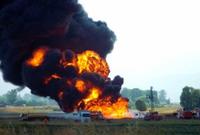-
Proposed Salt Lake City prison at risk from tsunami waves in event of earthquake
Salt Lake City mayor Ralph Becker is warning Utah state leaders that if a proposed prison is constructed on the shores of the Great Salt Lake, it could be at risk of a major tsunami damage in the event of an earthquake in the region. “It all sounds far-fetched that a big earthquake could result in tsunami-like waves on the lake, but it is possible. Basically, I think it is a terrible idea to put a prison there or an industrial park or any other major development because of the hazard from the lake,” says one seismologist.
-
-
Ten years after the Boxing Day tsunami, are coasts any safer?
Ten years ago we witnessed one of the worst natural disasters in history, when a huge earthquake off the coast of Sumatra triggered a devastating tsunami which swept across the Indian Ocean. An estimated 230,000 people lost their lives, and 1.6 million people lost their homes or livelihoods. The impact was greatest in northern Sumatra because of its proximity to the earthquake. Catastrophic shaking was followed within minutes by the full force of the tsunami. Thousands of people were also killed in distant countries, where the earthquake could not be felt. If they had received a warning of the approaching tsunami, they could have moved inland, uphill or out to sea, and survived. Future tsunami disasters are inevitable, but with better technology, education and governance we can realistically hope that a loss of life on the scale of the 2004 tsunami disaster will not happen again.
-
-
If South Korea’s nuclear plant staff are vulnerable, then so are the reactors
Does it matter that a South Korean nuclear plant was hacked and plans of the complex stolen? As it is South Korea that’s the subject of this latest attack, everyone tends to assume it must have had something to do with North Korea. With a target as sensitive as a nuclear power plant, not unreasonably people are asking if safety could be compromised by a cyberattack. Could hackers cause the next Chernobyl or Three Mile Island? This points to an important and infrequently discussed problem, the vulnerability of critical national infrastructure. Cyber-attacks like these are a great way of levelling the playing field: why invest in massively expensive nuclear weapons program if you can simply shut down your enemies’ power, gas, water, and transportation systems? Increasingly more and more infrastructure is connected to the Internet, with all the security risks that entails.
-
-
Obama signs five cybersecurity measures into law
Last week President Barack Obama signed five cybersecurity-related pieces of legislation, including an update to the Federal Information Security Management Act(FISMA) — now called the Federal Information Security Modernization Act — the law which governs federal government IT security. Other cyber legislation the president signed includes the Homeland Security Workforce Assessment Act, the Cybersecurity Workforce Assessment Act, the National Cybersecurity Protection Act (NCPA), and the Cybersecurity Enhancement Act.
-
-
Helping coastal communities to visualize sea-level rise
As part of the Federal Emergency Management Agency’s (FEMA) initiative to encourage communities to become more aware of the effects of climate change, the agency has awarded Marin County, California a $150,000 grant to engage residents in climate change issues by allowing them to visualize the effects of sea level rise. The grant will pay for two sophisticated viewfinders programed to envision how the landscape will appear in projected sea level rise scenarios, as well as how the landscape appeared in the past.
-
-
L.A. water supply vulnerable to disruption by earthquakes
Eighty-eight percent of Los Angeles’s water comes from the Colorado River, Owens Valley, and the Sacramento-San Joaquin River Delta, passing through three major aqueducts and into the region. The aqueducts cross the San Andreas Fault a total of thirty-two times, making them vulnerable to the much anticipated Big One.A large temblor on the fault could destroy sections of the aqueducts, cutting off the water supply for more than twenty-two million people in Southern California.
-
-
It will take 11 trillion gallons to replenish California drought losses: NASA
Since 2011, the Sacramento and San Joaquin river basins decreased in volume by four trillion gallons of water each year (fifteen cubic kilometers). This is more water than California’s thirty-eight million residents use each year for domestic and municipal purposes. About two-thirds of the loss is due to depletion of groundwater beneath California’s Central Valley. It will take about eleven trillion gallons of water (forty-two cubic kilometers) — around 1.5 times the maximum volume of the largest U.S. reservoir — to recover from California’s continuing drought, according to a new analysis of NASA satellite data.
-
-
Placing people in affordable homes within days, not years, after major storms
On Monday, Housing and Urban Developmentsecretary Julian Castro toured the core of a house in Brownsville, Texas, as part of the RAPIDO project, which local officials hope will one day become the model for housing recovery after a major storm. The house is part of a $2 million pilot project which relies on low construction expenses and affordable labor to get people in affordable homes within days of a major disaster instead of years. While hundreds of affordable homes have been built since Hurricane Dolly and Ike destroyed a vast portion of the Texas Gulf Coast in 2008, many residents are still waiting for houses already funded with federal disaster money.
-
-
Industry: Multiple redundant and back-up systems make nuclear plants safer than ever
Nuclear plants receive what supporters of nuclear power regard as an unfair amount of scrutiny and concern for their safety, but industry experts say that plant equipment and plant operations are highly regulated to minimize risks.All U.S. nuclear plants are now storing emergency pumps, generators, battery banks, chargers, compressors, and hoses at off-site locations near the plants to protect against floods, industry insiders say.Working in a nuclear plant is much safer than working in a paper mill or a chemical plant, according to Jim Krafty, a Nuclear Regulatory Commission (NRC) resident senior inspector at the Beaver Valley nuclear power plant in Shippingport, Pennsylvania.
-
-
Better forecasts for rain-on-snow flooding
Many of the worst West Coast winter floods pack a double punch. Heavy rains and melting snow wash down the mountains together to breach river banks, wash out roads and flood buildings. These events are unpredictable and difficult to forecast. Yet they will become more common as the planet warms and more winter precipitation falls as rain rather than snow. Mountain hydrology experts are using the physics behind these events to better predict the risks.
-
-
Be prepared: What to do if an asteroid is heading our way

Last month, experts from European Space Agency’s (ESA) Space Situational Awareness (SSA) program and Europe’s national disaster response organizations met for a two-day exercise on what to do if an asteroid is ever found to be heading our way. The exercise considered the threat from an imaginary, but plausible, asteroid, initially thought to range in size from twelve meters to thirty-eight meters — spanning roughly the range between the 2013 Chelyabinsk airburst and the 1908 Tunguska event — and travelling at 12.5 km/s. Teams were challenged to decide what should happen at five critical points in time, focused on 30, 26, 5, and 3 days before and one hour after impact.
-
-
2008 Turkish oil pipeline explosion may have been Stuxnet precursor

The August 2008 Baku-Tbilisi-Ceyhan (BTC) oil pipeline explosion in Refahiye, eastern Turkey, was ruled at the time to be an accident resulting from a mechanical failure, which itself was a result of an oversight by Turkish government’s supervisors. Western intelligence services concluded that the explosion was the result of a cyberattack. According to people familiar with an investigation of the incident, hackers had infiltrate the pipeline’s surveillance systems and valve stations, and super-pressurized the crude oil in the pipeline, causing the explosion.
-
-
Better defense barriers and technologies for better protection against floods
Hurricanes are devastating. Aside from the high, sustained wind speeds, they usually bring with them heavy rain, which can quickly lead to the breaching of flood defenses in susceptible areas. Now, U.S. and U.K. researchers have reviewed hurricane flood defense barriers and technologies with a view to helping engineers find improved designs.
-
-
Coastal defenses could contribute to flooding with sea-level rise
A combination of coastal defenses and rising sea levels could change typical U.K. tidal ranges, potentially leading to a higher risk of flooding, say scientists. The researchers wanted to find out how tides around the United Kingdom might respond to changes in sea level over the next century depending on the level of coastal defenses in place. Their study shows for the first time that local coastal defenses, such as sea walls, could cause tides to change dramatically. It suggests flood defenses need to be reassessed on an international scale as they may lead to an increased risk of flooding.
-
-
Nuclear power should play “substantial role” in mitigating climate change: Environmental scientists
Leading conservation scientists from around the world have called for a substantial role for nuclear power in future energy-generating scenarios in order to mitigate climate change and protect biodiversity. In an open letter to environmentalists with more than sixty signatories, the scientists ask the environmental community to “weigh up the pros and cons of different energy sources using objective evidence and pragmatic trade-offs, rather than simply relying on idealistic perceptions of what is ‘green’.”
-
More headlines
The long view
Water Wars: A Historic Agreement Between Mexico and US Is Ramping Up Border Tension
As climate change drives rising temperatures and changes in rainfall, Mexico and the US are in the middle of a conflict over water, putting an additional strain on their relationship. Partly due to constant droughts, Mexico has struggled to maintain its water deliveries for much of the last 25 years, deliveries to which it is obligated by a 1944 water-sharing agreement between the two countries.
Trump Is Fast-Tracking New Coal Mines — Even When They Don’t Make Economic Sense
In Appalachian Tennessee, mines shut down and couldn’t pay their debts. Now a new one is opening under the guise of an “energy emergency.”
Smaller Nuclear Reactors Spark Renewed Interest in a Once-Shunned Energy Source
In the past two years, half the states have taken action to promote nuclear power, from creating nuclear task forces to integrating nuclear into long-term energy plans.
Keeping the Lights on with Nuclear Waste: Radiochemistry Transforms Nuclear Waste into Strategic Materials
How UNLV radiochemistry is pioneering the future of energy in the Southwest by salvaging strategic materials from nuclear dumps –and making it safe.
Model Predicts Long-Term Effects of Nuclear Waste on Underground Disposal Systems
The simulations matched results from an underground lab experiment in Switzerland, suggesting modeling could be used to validate the safety of nuclear disposal sites.
